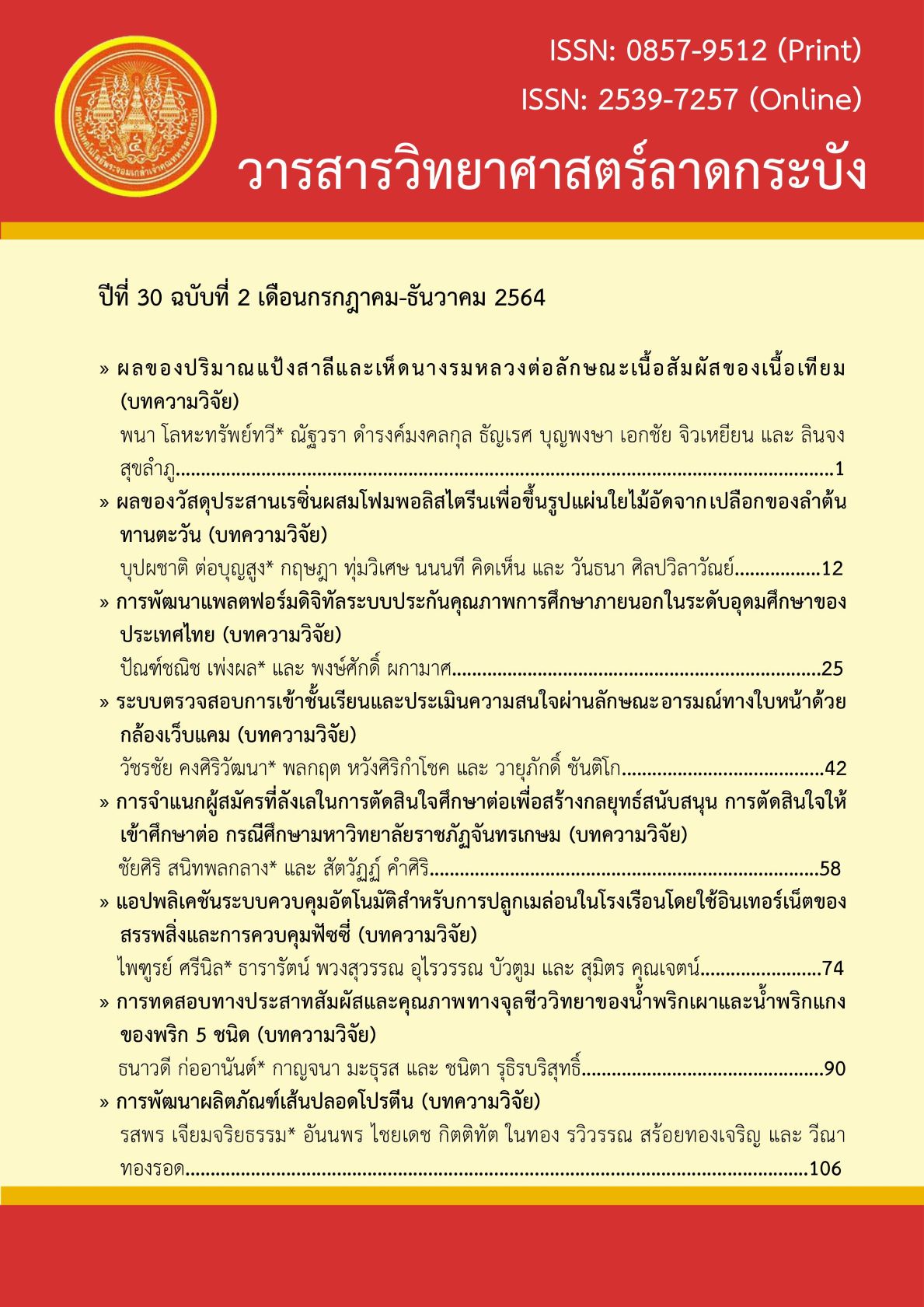ระบบตรวจสอบการเข้าชั้นเรียนและประเมินความสนใจผ่านลักษณะอารมณ์ทางใบหน้าด้วยกล้องเว็บแคม
Main Article Content
บทคัดย่อ
งานวิจัยนี้มีแนวคิดในการตรวจสอบสถานะการเข้าชั้นเรียนผ่านใบหน้าโดยการใช้กล้องเว็บแคม (Webcam) ในการตรวจจับนักศึกษาในชั้นเรียนแบบเรียลไทม์ และนำผลการแสดงอารมณ์ทางใบหน้าของนักศึกษาขณะทำการเรียนในช่วงเวลาดังกล่าว มาทำการประเมินผลความสนใจในการเรียน บนพื้นฐานชุดข้อมูลการตรวจจับอารมณ์ทางใบหน้า ประกอบไปด้วยหน้า “ปกติ” “มีความสุข” “ประหลาดใจ” “โกรธ” “เศร้า” และ “กลัว” การทำงานของระบบนี้จะประกอบไปด้วย 2 ส่วนคือ ฝั่งอาจารย์ และฝั่งนักศึกษา โดยฝั่งอาจารย์จะมีหน้า Dashboard แสดงสถานะของนักศึกษาที่เข้าสู่ระบบในวิชาที่ลงทะเบียนเรียน และเปอร์เซ็นต์สรุปผลความสนใจในการเรียนรายบุคคล ขณะที่ฝั่งนักศึกษาจะสามารถเข้าสู่ระบบด้วยการเข้าร่วมรายวิชาผ่านรหัสที่ได้รับจากฝั่งอาจารย์ เพื่อสามารถตรวจสอบเปอร์เซ็นต์สรุปความสนใจในการเรียนของตนเองได้ การตรวจจับใบหน้าจะทำงานร่วมกับแบบจำลอง MobileFaceNet เพื่อแยกแยะและจดจำใบหน้าของนักศึกษาแต่ละคน แล้วทำการเปรียบเทียบกับชุดข้อมูลแบบจำลองตรวจจับอารมณ์ทางใบหน้า mini-Xception เพื่อทราบได้ว่านักศึกษาแต่ละคนอยู่ในสถานะอารมณ์อะไร โดยจำแนกกลุ่มอารมณ์ทางใบหน้า คือ “ปกติ มีความสุข ประหลาดใจ” แสดงถึงความสนใจ ขณะเดียวกันกลุ่มอารมณ์ทางใบหน้า คือ “โกรธ เศร้า กลัว” แสดงถึงความไม่สนใจ เมื่อใดก็ตามที่สิ้นสุดการทำงาน ระบบจะทำการคำนวณเปอร์เซ็นต์ความสนใจและไม่สนใจของนักศึกษา และสถานะการเข้าชั้นเรียนออกเป็นผลสรุป ซึ่งผลการทดสอบกับกลุ่มตัวอย่างในชั้นเรียนจำนวน 4 คน ทดสอบระบบเพื่อหาความสนใจและไม่สนใจในการเข้าชั้นเรียนจำนวน 3 ครั้ง ครั้งละ 30 นาที ได้ผลลัพธ์ความสนใจเฉลี่ยโดยรวมเท่ากับ 82.81 % และความไม่สนใจเท่ากับ 17.19%
Article Details
เอกสารอ้างอิง
Jiranantanagorn, P. and Shen, H. 2016. Sentiment analysis and visualisation in a backchannel system. In Proceedings of the 28th Australian Conference on Computer-Human Interaction, 353-357.
Leitner, P., Kung-Keat, T. and Ng, J. 2016. Confused, bored, excited? An emotion based approach to the design of online learning systems. In 7th International Conference on University Learning and Teaching (InCULT 2014) Proceedings, 221-233. Springer, Singapore.
Behnke, S. 2003. Hierarchical neural networks for image interpretation. Vol. 2766. Springer.
Essid, O., Laga, H. and Samir, C. 2018. Automatic detection and classification of manufacturing defects in metal boxes using deep neural networks. PLoS ONE, 13(11), e0203192.
วัชรชัย คงศิริวัฒนา และสรัญญา สว่างศรี. 2563. การตรวจสอบคุณภาพของถุงปูนด้วยวิธีการประมวลผลภาพโดยใช้โครงข่ายประสาทเทียมคอนโวลูชัน: กรณีศึกษากระบวนการผลิตถุงปูนซีเมนต์. PSRU Journal of Science and Technology, 5(1), 93-106. [Watcharachai Kongsiriwattana and Sarunya Sawangsri. 2020. The Quality Detection of Cement Bags by Using Image Processing with Convolutional Neural Networks: Case Study of a Manufacture Production Line of Cement Bags. PSRU Journal of Science and Technology, 5(1), 93-106. (in Thai)]
Datta, A.K., Datta, M. and Banerjee, P.K. 2015. Face Detection and Recognition: Theory and Practice. Chapman and Hall/CRC.
Kortli, Y., Jridi, M., Falou, A.A. and Atri, M. 2020. Face Recognition Systems: A Survey. Sensors (Basel, Switzerland), 20(2), 342.
Tarnowski, P., Kolodziej, M., Majkowski, A. and Rak, R.J. 2017. Emotion recognition using facial expressions. Procedia Computer Science, 108, 1175-1184.
Arriaga, O., Valdenegro-Toro, M. and Plöger, P. 2017. Real-time convolutional neural networks for emotion and gender classification. Available at: https://https://arxiv. org/abs/1710.07557. Retrieved 9 Jan 2021.
Ultra-Light Fast Generic Face Detector [Online], Available at: https://github.com/ Linzaer/Ultra-Light-Fast-Generic-Face-Detector-1MB. Retrieved 30 November 2020.
Yang, D., Alsadoon, A., Prasad, P.W.C., Singh, A.K. and Elchouemi, A. 2018. An emotion recognition model based on facial recognition in virtual learning environment. Procedia Computer Science, 125, 2-10.
Krithika, L.B. and Lakshmi, P.G.G. 2016. Student emotion recognition system (SERS) for e-learning improvement based on learner concentration metric. Procedia Computer Science, 85, 767-776.
Khalfallah, J. and Slama, J.B.H. 2015. Facial expression recognition for intelligent tutoring systems in remote laboratories platform. Procedia Computer Science, 73, 274-281.
Putra, W.B. and Arifin, F. 2019. Real-Time Emotion Recognition System to Monitor Student’s Mood in a Classroom. Journal of Physics: Conference Series, 1413, 012021.
Jiranantanagorn, P., Bhardwaj, P., Li, R., Shen, H., Goodwin, R. and Teoh, K.K. 2015. Designing a Mobile Digital Backchannel System for Monitoring Sentiments and Emotions in Large Lectures. In Proceedings of the ASWEC 2015 24th Australasian Software Engineering Conference, 141-144.
Google Classroom for Education [Online], Available at: https://edu.google.com/ products/classroom/. Retrieved 9 January 2021.
Prince, S.J.D., Elder, J., Hou, Y., Sizinstev, M. and Olevskiy, E. 2006. Towards Face Recognition at a Distance, IET Conference on Crime and Security, London, 570-575.
Hassouneh, A., Mutawa, A.M. and Murugappan, M. 2020. Development of a Real-Time Emotion Recognition System Using Facial Expressions and EEG based on machine learning and deep neural network methods. Informatics in Medicine Unlocked, 20, 100372.

